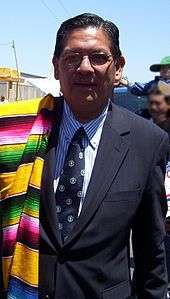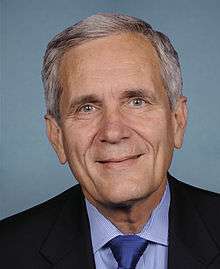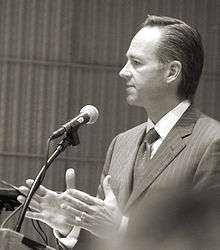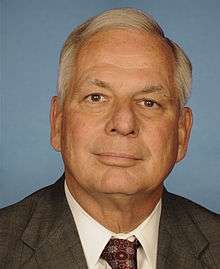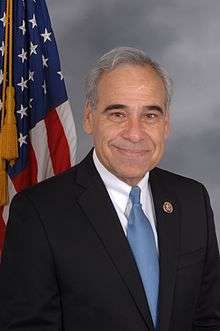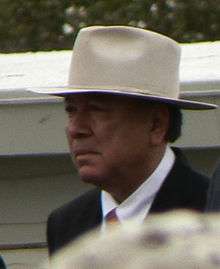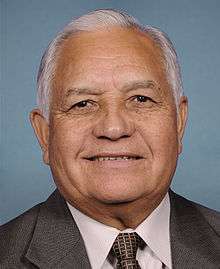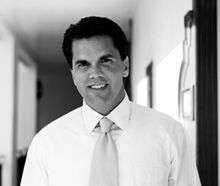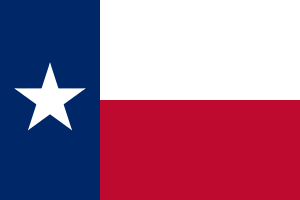Texas Democratic Party
Texas Democratic Party | |
|---|---|
| Chairperson | Gilberto Hinojosa |
| Senate leader | José R. Rodríguez |
| House leader | Yvonne Davis |
| Founded | 1846 |
| Headquarters |
P.O. Box 116 Austin, Texas 78767 |
| Student wing | Texas College Democrats |
| Ideology |
Liberalism Progressivism Social liberalism |
| Political position | Center-left |
| National affiliation | Democratic Party |
| Seats in State Upper Houses |
11 / 31 |
| Seats in State Lower Houses |
51 / 150 |
| Website | |
|
www | |
The Texas Democratic Party is one of the two major political parties in the U.S. state of Texas, representing the Democratic Party. It is headquartered in Downtown Austin, Texas.[1]
History
Prior to the Annexation of Texas, the Democratic Party had a foothold in the politics of the region. A powerful group of men that called themselves the "Texas Association" served as an early prototype for the Democratic Party of Texas. The Texas Association drew its membership from successful merchants, doctors, and lawyers, often traveling from Tennessee. Many members of the Texas Association were close friends of Andrew Jackson, and most had strong ties to the Democratic Party. Similarly, most of the other settlers in Texas were from states in the south, and American southerners of this era generally held strong allegiances to the Democratic Party.[2]
In 1845, the 29th United States Congress approved the Texas Constitution and President James K. Polk signed the act admitting Texas as a state on December 29. In 1848, the party convention system was adopted, and it quickly became the primary method of selecting candidates for the Texas Democratic Party. In the period prior to the Civil War, national politics influenced the state party’s perspective. Texas Democrats began to discard Jacksonian-nationalism in favor of the states' rights agenda of the Deep South. A conflict emerged within the Party between pro-Union Democrats and secessionists. During the war, supporters of the Union disappeared from the political scene or moved north. Those who stayed politically active reluctantly supported the Confederacy. During Reconstruction, the rift between Unionist and Secessionist Democrats remained. For a short period immediately after the war, the Texas Democratic Party was a formidable political force, but they quickly split apart because their positions on freedmen varied greatly; some supported full civil rights, while others opposed anything more than emancipation. As a result, Republicans captured both the governor's office and the Texas Legislature in 1869, but Republican political dominance in the post-Civil War era was short-lived. By 1872, the Texas Democrats had consolidated their party and taken over the Texas legislature.[3] For the remainder of the 19th century and well into the 20th, Democrats dominated Texas politics and Republicans were minor political players.
In the presidential election of 1928, anti-Catholicism in Texas and across the country swung the Lone Star State away from Democratic presidential nominee Al Smith, the first time it ever voted against a Democrat in a presidential election. However, it was not until the middle of the 20th century that the Democrats began to face a growing challenge from the Republican Party in earnest. The 1950s was a decade of factionalism and infighting for the Texas Democratic Party, mainly between liberal and conservative Democrats, and the Republicans managed to carry Texas for native Dwight D. Eisenhower in 1952 and 1956. Cohesion returned to the party in the 1960s, and the Democratic ticket carried Texas in the 1960 presidential election with prominent Texas Senator Lyndon B. Johnson running for Vice President. In 1962, John B. Connally, a moderate Democrat, was elected Governor of Texas. The next year, the assassination of President John F. Kennedy on a trip to Dallas created further impetus to bridge the gap between liberal and moderate Texas Democrats; Party unity was solidified with Johnson's ensuing Presidency and the drubbing of Barry Goldwater in the 1964 presidential election. In 1964, Johnson carried his home state with ease, but liberal forces in Texas were in decline. In the 1968 presidential election, Democrat Hubert Humphrey barely managed to win Texas.
In 1976, Jimmy Carter became the last Democratic presidential candidate to carry Texas, and the tide was clearly turning when Democrats lost the gubernatorial election of 1978. Bill Clements was the first Republican governor since Reconstruction. By the 1990s Republicans had gained a strong foothold in the state, and throughout the 21st century they have been largely victorious. Currently, both houses of the Texas Legislature feature Republican majorities. At the federal level, Republicans hold both of the state's Senate seats and 24 out of the possible 36 House of Representatives seats allotted to Texas.[4]
The Texas Democratic Party has not won a statewide election since 1994.[5]
Activities
The Texas Democratic Party is the primary organization responsible for increasing the representation of its ideological base in state, district, county, and city government. Its permanent staff provides training and resources for Democratic candidates within the state, particularly on grassroots organization and fundraising.[6] The Party organization monitors political discourse in the state and speaks on behalf of its members. The party employs a full-time Communications Director who is responsible for the organization's communications strategy, which includes speaking with established state and national media. Press releases regarding current issues are often released through the by permanent staff.[7] The party also maintains a website with updates and policy briefs on issues pertinent to its ideological base. Its online presence also includes Facebook and Twitter accounts, each of which has thousands of followers and is used to update followers on the most recent events affecting the party. The Party also employs several e-mail groups that send periodic updates to millions of followers.[4]
A major function of the Texas Democratic Party is to raise funds to maintain the electoral infrastructure within its organization. Funds are used to provide for a permanent staff, publish communication and election material, provide training to candidates, and to pay for legal services.
The organization hosts biennial conventions that take place at precinct, county, and state level. The purpose of the precinct convention is to choose delegates to the county convention, and the delegates who gather at the county conventions are mainly concerned with selecting delegates to the state convention. The purpose of the state convention is to appoint the state executive committee, adopt a party platform, and officially certify the party's candidates to be listed on the general election ballot. The State Democratic Executive Committee (SDEC) includes one man and one woman from each district, plus a chairman and a vice-chairman. The SDEC members are technically appointed, but they are voted on by the convention’s delegates.[4] In presidential election years, the state convention also chooses delegates to go to the Democratic National Convention. Delegates also elect a state party chair. At the 2012 Texas Democratic Party Convention in Houston, delegates elected Gilberto Hinojosa as the new chair of the state party. Hinojosa is a former school board trustee, district judge, and county judge from Cameron County.[8] Hinojosa replaced retiring chair Boyd Richie, who had been chair since April 22, 2006.
Controversies
Texas eleven
In 2003, a group of Democratic state legislators referred to as the Texas Eleven fled to New Mexico and Oklahoma, to prevent the passage of dramatic redistricting legislation. Republicans had been pushing redistricting because Democrats had been sending more representatives to Congress, even though the state's voters had leaned Republican in recent years. U.S. House Majority Leader Tom DeLay called for the lawful arrest of the Texas Eleven. Their absence prevented a quorum during a special 30-day session of the legislature; afterwards, when Senator John Whitmire conceded, the rest followed, because his presence on the Senate floor met quorum.
Texas Two-Step
At the 2010 convention, Texas Democrats voted to keep the controversial Two-Step system. Most states use either a primary or a caucus in order to determine presidential nominees, but Texas runs an combination of both. The antipathy towards George W. Bush and the allure of a contentious race drew almost 3 million Democrats to the primary polls. During the Democratic Presidential caucuses, thousands of new Texas Democrats showed up and overwhelmed the old-guard party officials. Factions of the Texas Democrats complained that this populist outburst wrought havoc on the caucus process. Almost immediately after the results, Party regulars began calling to change the system or even to abolish the caucus altogether. In the end, Hillary Clinton won the popular vote, but Barack Obama's well-organized campaign won the caucus.[9][10]
Current elected officials
The Texas Democratic Party holds twelve of the state's 36 U.S. House seats, 12 of the state’s 31 Texas Senate seats, and 55 of the state’s 150 Texas House of Representatives seats.
- Texas Democrats
Members of Congress
U.S. House of Representatives
The following members of the U.S. House of Representatives are Democrats:[11][12]
- Al Green, 9th District
- Rubén Hinojosa, 15th District
- Beto O'Rourke, 16th District
- Sheila Jackson Lee, 18th District
- Joaquín Castro, 20th District
- Henry Cuellar, 28th District
- Gene Green, 29th District
- Eddie Bernice Johnson, 30th District
- Marc Veasey, 33rd District
- Filemon Vela, Jr., 34th District
- Lloyd Doggett, 35th District
State offices
Texas Senate
The following Democrats represent their districts in the Texas Senate:[13][14]
- Sylvia Garcia, District 6
- Rodney Ellis, District 13
- Kirk Watson, District 14
- John Whitmire, District 15
- Carlos Uresti, District 19
- Juan "Chuy" Hinojosa, District 20
- Judith Zaffirini, District 21
- Royce West, District 23
- Jose Menendez, District 26
- Eddie Lucio, Jr., District 27
- José R. Rodríguez, District 29
Texas House of Representatives
The following Democrats represent their districts in the Texas House of Representatives:[15][16]
- Alma Allen, District 131
- Roberto R. Alonzo, District 104
- Carol Alvarado, District 145
- Rafael Anchia, District 103
- Diego Bernal, District 123
- Cesar Blanco, District 76
- Terry Canales, District 40
- Garnet Coleman, District 147
- Nicole Collier, District 95
- Yvonne Davis, District 111
- Joe Deshotel, District 22
- Dawnna Dukes, District 46
- Harold Dutton, District 142
- Joe Farias, District 118
- Jessica Farrar, District 148
- Helen Giddings, District 109
- Mary E. González, District 75
- R.D. "Bobby" Guerra, District 41
- Ryan Guillen, District 31
- Roland Gutierrez, District 119
- Ana Hernandez Luna, District 143
- Abel Herrero, District 34
- Donna Howard, District 48
- Celia Israel, District 50
- Eric Johnson, District 100
- Tracy O. King, District 80
- Oscar Longoria, District 35
- Eddie Lucio III, District 38
- Marisa Marquez, District 77
- Armando “Mando” Martinez, District 39
- Trey Martinez Fischer, District 116
- Ruth Jones McClendon, District 120
- Borris Miles, District 146
- Ina Minjarez, District 124
- Joe Moody, District 78
- Sergio Muñoz, Jr., District 36
- Elliott Naishtat, District 49
- Poncho Nevárez, District 74
- Rene Oliveira, District 37
- Joe Pickett, District 79
- Richard Pena Raymond, District 42
- Ron Reynolds, District 27
- Eddie Rodriguez, District 51
- Justin Rodriguez, District 125
- Ramon Romero, District 90
- Toni Rose, District 110
- Senfronia Thompson, District 141
- Chris Turner, District 101
- Sylvester Turner, District 139
- Hubert Vo, District 149
- Armando Walle, District 140
- Gene Wu, District 137
State Board of Education
The following members of the State Board of Education are Democrats; they help oversee the Texas Education Agency:[17]
- Martha Dominguez, District 1
- Ruben Cortez Jr., District 2
- Marisa Perez, District 3
- Lawrence A. Allen, Jr., District 4
- Erika Beltran, District 13
Judiciary
Members of the Texas Supreme Court and the Texas Court of Criminal Appeals are elected in statewide, partisan elections. The sole statewide office currently held by the Democratic Party in Texas is a seat on the Court of Criminal Appeals; the incumbent has held the seat since 1993 and switched his party affiliation from Republican to Democratic in December 2013.[18]
- Lawrence Meyers, Texas Court of Criminal Appeals, Place 2
References
- ↑ "Contact". Texas Democratic Party. 2012. Retrieved 2012-06-04.
- ↑ "Texas State Historical Association". Retrieved 19 August 2012.
- ↑ "Scalawag#cite ref-1." Republican Politics and Reconstruction
- 1 2 3 Young, Nancy Beck. "Democratic Party". Texas State Historical Association. Retrieved 2012-06-10.
- ↑ Selby, W. Gardner. "Texas Democrats shut out of statewide office longer than Democrats in other states". PolitiFact. Retrieved 2014-10-15.
- ↑ Texas State Historical Association: Texas Democratic Handbook. Retrieved December 5, 2011
- ↑ Texas Democratic Party Official Website: Media Staff. Retrieved December 5, 2011
- ↑ Ramsay, Ross; Aguilar, Julián (2012-06-09). "Texas Democrats Elect Their First Hispanic Chairman". Retrieved August 19, 2012.
- ↑ Brandi Grissom and Reeve Hamilton (27 June 2010). "Democrats Keep Controversial "Texas Two-Step"". The Texas Tribune. Retrieved 19 August 2012.
- ↑ Carolyn Feibel (1 March 2008). "A guide to Texas' electoral two-step- High turnout could make an already confusing process clumsy". Houston Chronicle. Retrieved 19 August 2012.
- ↑ U.S. House of Representatives Texas Tribune. Retrieved June 16, 2015
- ↑ U.S. House of Representatives U.S. House of Representatives. Retrieved June 16, 2015
- ↑ Elected Officials Texas Tribune. Retrieved June 16, 2015
- ↑ List of Texas Senate Members The Senate of Texas. Retrieved June 16, 2015
- ↑ Texas House of Representatives Texas Tribune. Retrieved June 16, 2015
- ↑ Texas House of Representatives Texas State Directory. Retrieved June 16, 2015
- ↑ State Board of Education Texas Tribune. Retrieved June 16, 2015
- ↑
